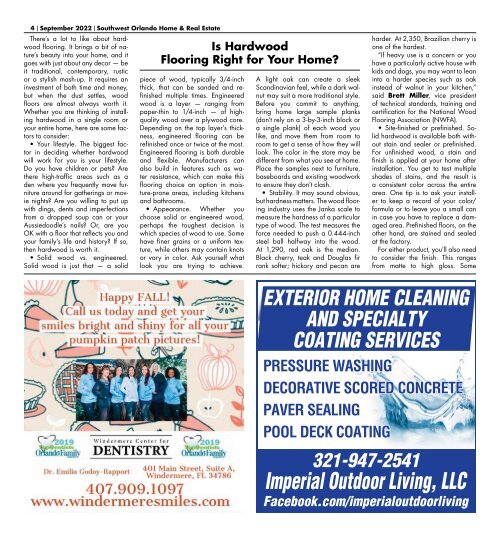091522_SW_Taste The Town_DIGITAL EDITION
Create successful ePaper yourself
Turn your PDF publications into a flip-book with our unique Google optimized e-Paper software.
4 x September 2022 x Southwest Orlando Home & Real Estate<br />
<strong>The</strong>re’s a lot to like about hardwood<br />
flooring. It brings a bit of nature’s<br />
beauty into your home, and it<br />
goes with just about any decor — be<br />
it traditional, contemporary, rustic<br />
or a stylish mash-up. It requires an<br />
investment of both time and money,<br />
but when the dust settles, wood<br />
floors are almost always worth it.<br />
Whether you are thinking of installing<br />
hardwood in a single room or<br />
your entire home, here are some factors<br />
to consider:<br />
• Your lifestyle. <strong>The</strong> biggest factor<br />
in deciding whether hardwood<br />
will work for you is your lifestyle.<br />
Do you have children or pets? Are<br />
there high-traffic areas such as a<br />
den where you frequently move furniture<br />
around for gatherings or movie<br />
nights? Are you willing to put up<br />
with dings, dents and imperfections<br />
from a dropped soup can or your<br />
Aussiedoodle’s nails? Or, are you<br />
OK with a floor that reflects you and<br />
your family’s life and history? If so,<br />
then hardwood is worth it.<br />
• Solid wood vs. engineered.<br />
Solid wood is just that — a solid<br />
Is Hardwood<br />
Flooring Right for Your Home?<br />
piece of wood, typically 3/4-inch<br />
thick, that can be sanded and refinished<br />
multiple times. Engineered<br />
wood is a layer — ranging from<br />
paper-thin to 1/4-inch — of highquality<br />
wood over a plywood core.<br />
Depending on the top layer’s thickness,<br />
engineered flooring can be<br />
refinished once or twice at the most.<br />
Engineered flooring is both durable<br />
and flexible. Manufacturers can<br />
also build in features such as water<br />
resistance, which can make this<br />
flooring choice an option in moisture-prone<br />
areas, including kitchens<br />
and bathrooms.<br />
• Appearance. Whether you<br />
choose solid or engineered wood,<br />
perhaps the toughest decision is<br />
which species of wood to use. Some<br />
have finer grains or a uniform texture,<br />
while others may contain knots<br />
or vary in color. Ask yourself what<br />
look you are trying to achieve.<br />
A light oak can create a sleek<br />
Scandinavian feel, while a dark walnut<br />
may suit a more traditional style.<br />
Before you commit to anything,<br />
bring home large sample planks<br />
(don’t rely on a 3-by-3-inch block or<br />
a single plank) of each wood you<br />
like, and move them from room to<br />
room to get a sense of how they will<br />
look. <strong>The</strong> color in the store may be<br />
different from what you see at home.<br />
Place the samples next to furniture,<br />
baseboards and existing woodwork<br />
to ensure they don’t clash.<br />
• Stability. It may sound obvious,<br />
but hardness matters. <strong>The</strong> wood flooring<br />
industry uses the Janka scale to<br />
measure the hardness of a particular<br />
type of wood. <strong>The</strong> test measures the<br />
force needed to push a 0.444-inch<br />
steel ball halfway into the wood.<br />
At 1,290, red oak is the median.<br />
Black cherry, teak and Douglas fir<br />
rank softer; hickory and pecan are<br />
harder. At 2,350, Brazilian cherry is<br />
one of the hardest.<br />
“If heavy use is a concern or you<br />
have a particularly active house with<br />
kids and dogs, you may want to lean<br />
into a harder species such as oak<br />
instead of walnut in your kitchen,”<br />
said Brett Miller, vice president<br />
of technical standards, training and<br />
certification for the National Wood<br />
Flooring Association (NWFA).<br />
• Site-finished or prefinished. Solid<br />
hardwood is available both without<br />
stain and sealer or prefinished.<br />
For unfinished wood, a stain and<br />
finish is applied at your home after<br />
installation. You get to test multiple<br />
shades of stains, and the result is<br />
a consistent color across the entire<br />
area. One tip is to ask your installer<br />
to keep a record of your color/<br />
formula or to leave you a small can<br />
in case you have to replace a damaged<br />
area. Prefinished floors, on the<br />
other hand, are stained and sealed<br />
at the factory.<br />
For either product, you’ll also need<br />
to consider the finish. This ranges<br />
from matte to high gloss. Some<br />
EXTERIOR HOME CLEANING<br />
AND SPECIALTY<br />
COATING SERVICES<br />
PRESSURE WASHING<br />
DECORATIVE SCORED CONCRETE<br />
PAVER SEALING<br />
POOL DECK COATING<br />
321-947-2541<br />
Imperial Outdoor Living, LLC<br />
Facebook.com/imperialoutdoorliving

















